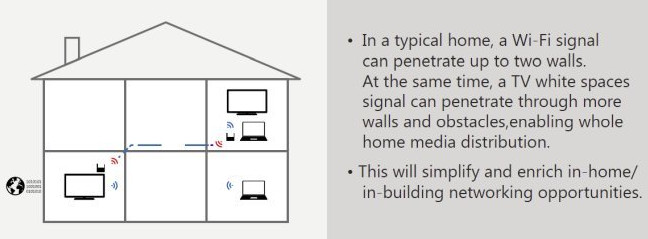TV whitespace spectrum represents the frequencies unused by analog TV channels either because noone is broadcasting at a given frequency or because of analog TV sunset. There are plans to use this free spectrum for the Internet of Things with Weightless, but instead Microsoft plans to leverage this new bandwidth for Internet access in remote areas.
 There are some hurdles to this technology as government must approve use of TV whitespace spectrum for use other than TV signals, and the receiver is now rather expensive at $1000, but Microsoft expects the price to come down to around $200.
There are some hurdles to this technology as government must approve use of TV whitespace spectrum for use other than TV signals, and the receiver is now rather expensive at $1000, but Microsoft expects the price to come down to around $200.
The advantage of TV frequencies is that they can be used over long distances, and easily penetrate through walls. The company has apparently started working on the technology since the end of 2012, and they now have pilot programs in various countries including the US, the UK, Jamaica, Namibia, Kenya, Taiwan and others.
Those projects have been running for some time, but this is now news because the technology will be/has been demonstrated in New York today, with the service becoming available in 12 states in the US soon, not from Microsoft directly, bu via local ISPs.
Via Liliputing.

Jean-Luc started CNX Software in 2010 as a part-time endeavor, before quitting his job as a software engineering manager, and starting to write daily news, and reviews full time later in 2011.
Support CNX Software! Donate via cryptocurrencies, become a Patron on Patreon, or purchase goods on Amazon or Aliexpress





On another news site Microsoft’s plan gets a kicking
“.In response, NAB Executive Vice President of Communications Dennis Wharton, described it as “the height of arrogance” for Microsoft – a $540 billion company – to demand free, unlicensed spectrum after refusing to bid on broadcast TV airwaves in the recent FCC incentive auction. “Microsoft’s white space device development has been a well-documented, unmitigated failure. Policymakers should not be misled by slick Microsoft promises that threaten millions of viewers with loss of lifeline broadcast TV programming,” he warned.”
Seems all is not Rosey in Microsoft’s garden
@theguyuk
Translation — the NAB wants Microsoft to pay it billions for the spectrum their broadcasters got from the US government for free and that they are using for UHF stations that are broadcasting 24/7 home shopping networks (ie shopping channels that occasionally display an EBS alert, alias lifeline broadcast).
“TV whitespace spectrum represents the frequencies unused by analog TV channels” And the frequencies unused by digital TV stations. Most Western nations no longer have any transmissions of analog TV and the digital TV transmissions occupy much of the lower UHF frequencies (the higher ones being cleared for cellphone transmissions). (USA also still uses VHF frequences as well as UHF frequencies.) The trial of broadband over TVWS in the UKofGB&NI was in Cambridge over five years ago. Since then the only scheme in operation is on the Isle of Arran in Scotland (since 2016?) which covers only a very small… Read more »
@Jon Smirl
“the NAB wants Microsoft to pay it billions”
If Microsoft or any of the TVWS ISPs were to pay for using UHF spectrum the money would not and never would be going to the NAB but would be paid to the federal government.
@Arthur Frayn
Under the rules of that auction that MS did not participate in the money would go to the US government, but then 50% was going to be paid out to the NAB broadcasters as “compensation” for surrendering the spectrum they currently occupy. It was an “incentive” auction.
I’m not an expert in this, but this is what I recall from reading about the situation over the last couple of years…. CableTV has caused the over the air viewership of UHF stations to drop to basically zero. But these UHF stations are still valuable for two reasons. First is the must carry rule on cable that was meant to protect religious broadcasters. The UHF stations sell their airtime 24/7 to home shopping operators and then use the must carry rule to force cable to give them a channel for free. This is a profitable business which pointlessly consumes… Read more »
I warmly recommend you to watch this presentation at last Battlemesh on this open source wifi downconverter made by Elektra:
https://www.youtube.com/watch?v=7gUvNM8Zbqs
@Jon Smirl “CableTV has caused the over the air viewership of UHF stations to drop to basically zero.” You are aware that in some markets, one or main affiliate stations are on a UHF channel rather than a VHF channel? For example in one major market, Detroit, the CBS affiliate (owned and operated by CBS) is broadcast on UHF channel 44. The PBS affiliate is also on UHF, namely channel 56. So not all UHF stations are just shopping networks. And that the channel used in a station’s unofficial name tag is their PSIP virtual channel number which although it… Read more »
” The PBS affiliate is also on UHF, namely channel 56.”
That should of course be channel 43. PSIP is 56, because WTVS was originally analog on channel 56.